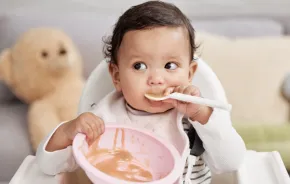 During my son’s first year, my husband and I were proud that we could hand him off to almost anyone and he was fine, happy even. Then I read that separation anxiety was an expected milestone for this age.
During my son’s first year, my husband and I were proud that we could hand him off to almost anyone and he was fine, happy even. Then I read that separation anxiety was an expected milestone for this age.
Cue parental worry.
“Have we had too many people care for him?” we wondered. “Shouldn’t he cling to us more?”
A few months later, he started burying his head in my chest in new situations and crying when I dropped him off at day care. This time I didn’t worry, but I did cry—though I knew, and was told, that he would be fine five minutes after I walked out the door.
Welcome to separation anxiety, a very normal phase of development for babies and toddlers that can be particularly distressing for parents, tapping as it does into our complex emotions about separation from our still-new children.
Parenting books will tell you that separation anxiety often starts late in the first year, when babies are becoming more mobile, begin to understand that they are separate from you and that, consequently, you can leave them. It often takes on renewed intensity from 18 months to 2 years of age.
“It’s an outgrowth of the attachment system, whose main function is to keep parents close by and protective. It becomes more critical when the infant becomes ambulatory,” says Dr. Matthew Speltz, clinical director of child and adolescent outpatient psychiatry at Seattle Children’s Hospital.
“Separation anxiety is a child’s way of showing that he or she is attached to parents and caregivers—this is a huge and important milestone,” says Jamila Reid, psychologist and former codirector of the University of Washington Parenting Clinic.
How children express this new understanding varies widely, from a slightly less happy “bye-bye” as they’re left at day care to zero tolerance for a parent leaving a room.
Except in a very small set of cases, it’s all normal, says Speltz. “Kids are hard-wired to experience separation anxiety. But temperament makes a big difference in the degree of stress that they show.”
Practice, prepare and be positive
So how can parents help children—and themselves—cope?
Practice can help. For babies, the time-tested game of peek-a-boo and very short separations—such as a trip to the next room, while a parent talks to them—helps them understand that separation always leads to reunion.
“Any time a new situation was coming, we practiced leave-taking many times,” says Rebecca Huntley, author of The Sleep Book for Tired Parents and mother of three boys. “Kids feel so much better when they know what to expect.”
Have a (brief) goodbye ritual. “For babies, it can be a hug and a kiss. For toddlers, a special snuggle, and then have the toddler wave goodbye or push the parent out the door,” says Reid. In a day-care setting, comfort objects from home can help, or, for older toddlers, photos of the parents.
Be positive, but acknowledge the emotions. “It’s very important for the parent not to sneak out, which can breed mistrust,” says Beth Goss, parent education instructor at North Seattle Community College. “We often feel that our kids need to be happy all the time, but it’s valuable for them to feel strong emotions like sadness and for them to realize they can stop feeling sad.”
And keep your parental radar up, just in case there is something else going on. Reid notes that if your child’s distress at being left with a certain caregiver shows no signs of improving after a period of time, then “there might be something about the setting that is wrong for your child.”
In most cases, parents should feel fine about leaving, says Speltz. “But if separation distress is affecting developmental milestones, such as language, exploration of the environment or interactions with peers, or if the child suffers long periods of distress after departure, it would be good to alert your pediatrician.”
This, too, shall pass
Finally, recognize that you only have so much control. “There is nothing you can do to prevent or ‘fix’ developmental issues. They simply take time and patience,” says Huntley. “I encourage parents to celebrate the development that is behind it.”
Parent education instructor Goss laughs when she recalls her ordeal. When her now-teenage daughter was a toddler, she received care at the same child-care center where Goss taught. Despite her proximity to her mother, her daughter cried and clung when Goss left her in the morning. “I literally had to peel her off my body,” Goss says. “This went on for years.”
Goss tried a number of strategies—a very consistent goodbye routine, asking her daughter to paint a picture for her while she was gone—which helped only slightly.
“I finally realized this is how she said goodbye to me. And after I left, she was fine.”
Elisa Murray is a Seattle-based writer and mother of a 2-year-old boy.









